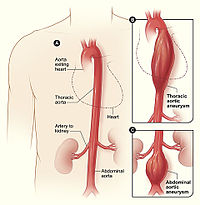
Photo from wikipedia
Purpose Hypertrophic pachymeningitis associated with immunoglobulin G4-related disease (IgG4-RD) has been rarely reported, and there is little information and no clear consensus on the management of IgG4-related spinal pachymeningitis (IgG4-RSP).… Click to show full abstract
Purpose Hypertrophic pachymeningitis associated with immunoglobulin G4-related disease (IgG4-RD) has been rarely reported, and there is little information and no clear consensus on the management of IgG4-related spinal pachymeningitis (IgG4-RSP). The present study described its possible clinical features, including the symptoms, imaging, treatment and prognosis of patients with IgG4-RSP. Methods We report three patients who presented with progressive neurological dysfunction due to spinal cord compression. Relevant articles were searched from the PubMed, Web of Science, and Embase databases, and the resulting literature was reviewed. Results The literature review provided a summary of 45 available cases, which included three cases from our center. Progressive worsening of neurological impairment was observed in 22 patients (48.9%). The lesions involved the thoracic spine (n=28, 62.2%), cervical spine (n=26, 57.8%), lumbar spine (n=9, 20.0%), and sacral spine (n=1, 2.2%). Furthermore, the lesions were located in the dura mater (n=18, 40.0%), epidural space (n=17, 37.8%), intradural-extramedullary space (n=9, 20.0%), and intramedullary space (n=1, 2.2%). On magnetic resonance imaging (MRI), the lesions generally appeared as striated, fusiform, or less often lobulated oval changes, with homogeneous (n=17,44.7%) and dorsal (n=15,39.5%) patterns being the most common. Thirty-five patients had homogeneous T1 gadolinium enhancement. Early surgical decompression, corticosteroid treatment, and steroid-sparing agents offered significant therapeutic advantages. A good therapeutic response to disease recurrence was observed with the medication. Conclusion The number of reported cases of IgG4-RSP remains limited, and patients often have progressive worsening of their neurological symptoms. The features of masses identified on the MRI should be considered. The prognosis was better with decompression surgery combined with immunosuppressive therapy. Long-term corticosteroid treatment and steroid-sparing agent maintenance therapy should be ensured. A systemic examination is recommended to identify the presence of other pathologies.
Journal Title: Frontiers in Oncology
Year Published: 2023
Link to full text (if available)
Share on Social Media: Sign Up to like & get
recommendations!